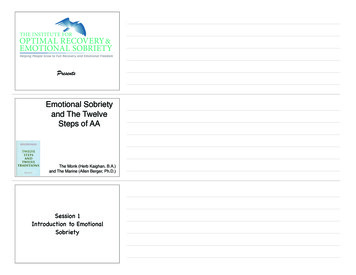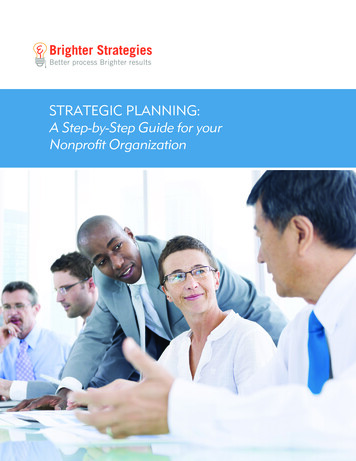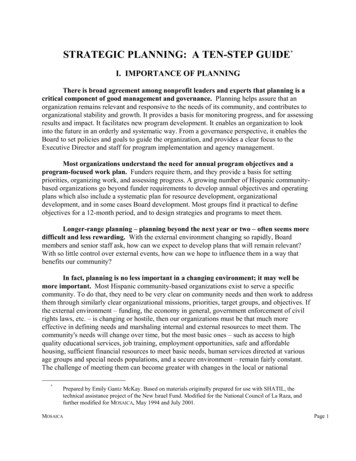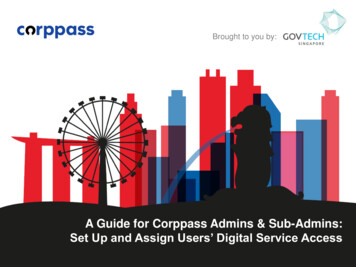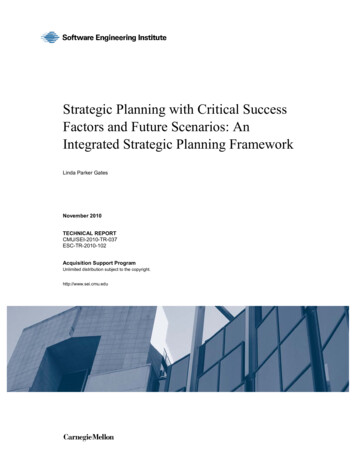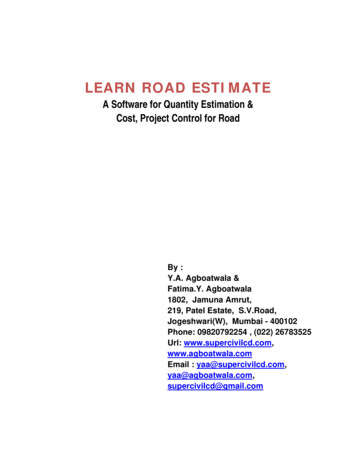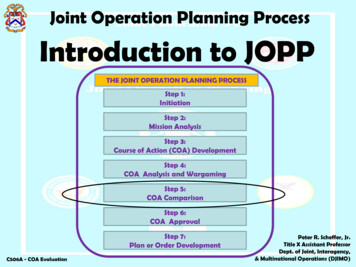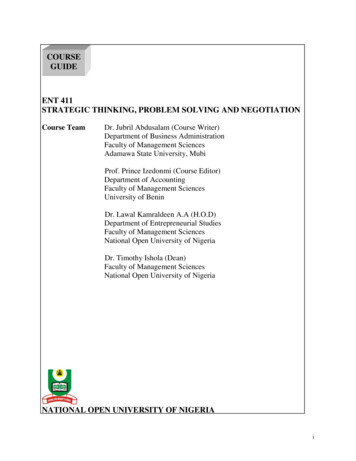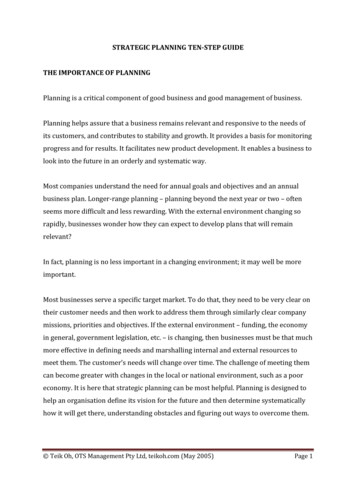
Transcription
STRATEGIC PLANNING TEN-STEP GUIDETHE IMPORTANCE OF PLANNINGPlanning is a critical component of good business and good management of business.Planning helps assure that a business remains relevant and responsive to the needs ofits customers, and contributes to stability and growth. It provides a basis for monitoringprogress and for results. It facilitates new product development. It enables a business tolook into the future in an orderly and systematic way.Most companies understand the need for annual goals and objectives and an annualbusiness plan. Longer-range planning – planning beyond the next year or two – oftenseems more difficult and less rewarding. With the external environment changing sorapidly, businesses wonder how they can expect to develop plans that will remainrelevant?In fact, planning is no less important in a changing environment; it may well be moreimportant.Most businesses serve a specific target market. To do that, they need to be very clear ontheir customer needs and then work to address them through similarly clear companymissions, priorities and objectives. If the external environment – funding, the economyin general, government legislation, etc. – is changing, then businesses must be that muchmore effective in defining needs and marshalling internal and external resources tomeet them. The customer’s needs will change over time. The challenge of meeting themcan become greater with changes in the local or national environment, such as a pooreconomy. It is here that strategic planning can be most helpful. Planning is designed tohelp an organisation define its vision for the future and then determine systematicallyhow it will get there, understanding obstacles and figuring out ways to overcome them. Teik Oh, OTS Management Pty Ltd, teikoh.com (May 2005)Page 1
There is an important caveat: Longer-range planning requires some level oforganisational stability. It is very difficult to plan in a crisis, and unrealistic to look fiveyears ahead unless an organisation has some confidence that it will exist next year, andthat most of its key staff and its leadership will continue to be working with theorganisation. Businesses also need the time to plan, which means that they must not beusing every minute to carry out activities required for survival.Moreover, while planning provides increased organisational definition, a sound base forplanning is consensus concerning a well-defined vision-mission statement and/ororganisational goals – these must often be developed as a foundation for longer-termplanning. It is also difficult to plan if the business is so young or its leadership so newthat they do not have a good sense of the business and of the broader externalenvironment.THE 10 STEP STRATEGIC PLANNING PROCESSThere are many different models and action steps for strategic planning. One approachis summarised below. It assumes a cooperative effort between management and staff,perhaps with a special strategic planning committee taking responsibility for the effort.Some of the work can be done in committee, while larger staff planning workshops orretreats are also likely to be required, both early and late in the planning process.Typical steps are described below, along with some suggested approaches for carryingout each step.Frequently, Steps 1-3 occur before a strategic planning retreat, Steps 4-7 during theretreat, and Steps 8-10 after the retreat. Teik Oh, OTS Management Pty Ltd, teikoh.com (May 2005)Page 2
1. Agree on a strategic planning process.This may be done at a committee meeting, or may require a special meeting or retreat,including some external stakeholders such as suppliers and customers. The criticalissue is to have leaders and opinion-makers in the company agreed about the value andneed for the process. At the session: Provide an understanding of what strategic planning is and how it isdone; Discuss its potential value to the business, in terms of providing acommon vision and focus, with agreed-upon goals and strategies; Consider the costs of doing strategic planning, in terms of staff otherresources – and what might need to be given up in order to develop aplan; if the business is in crisis or is financially or organisationallyunstable, it may be difficult or unwise to enter into a strategic planningprocess until the immediate problems and needs have been successfullyaddressed; Consider whether the business is "ready" for a long-range plan orwhether it may best focus on a short-term plan, perhaps doing a one-yearplan and then undertaking longer-term planning at the end of that year; If strategic planning seems appropriate, consider what procedures orsteps can be used to establish and implement a strategic plan (includingthe following); Agree upon a process and establish responsibilities for the various stepsin the process. Teik Oh, OTS Management Pty Ltd, teikoh.com (May 2005)Page 3
Except for a very small business, it will probably be desirable to set up a strategicplanning committee or task force. Choose participants carefully, assuring theircommitment to the process and their willingness to devote significant time to theplanning effort. Usually the coordinating group will include a mix ofowners/managers/leaders and staff. Some groups also include a representative oftechnical and/or support staff. Representatives of stakeholders – customers, suppliersand allies – might also be included. The organisation may also want to include anoutside facilitator or consultant who will assist with the process and with preparation ofthe strategic planning document.Be sure to allocate sufficient staff time to the strategic planning process. It may benecessary to reduce the regular workloads or responsibilities of staff members who areexpected to play a key role in developing the strategic plan.2. Carry out an environmental scan.This helps provide an understanding of how the business relates to its externalenvironment. The scan usually includes an external component -- identifying andassessing opportunities and threats in the external environment -- and an internalcomponent -- assessing the business’ strengths and weaknesses. This process is oftenreferred to as "SWOT" Analysis or strengths, weaknesses, opportunities, and threatsanalysis.The external component of the environmental scan should include a review of the targetmarket and the broader environment in which the business operates, to identify theopportunities and threats facing the business. This might include the following: Consider forces and trends in the broader political, economic, social,and sometimes technological (“PEST”) areas. In each area of PEST, lookat changing demographics, political trends, community values,economic trends, the implications of new or changing laws and Teik Oh, OTS Management Pty Ltd, teikoh.com (May 2005)Page 4
regulations affecting the business, communications and othertechnological trends -- and consider their impact on your business andthe customers it needs to serve. Look carefully at the immediate target market or product area todetermine its status and needs, and specifically those of current andpotential customers. Consider opportunities and challenges related to resources andfunding. Look at actual and potential collaborators and competitors.The internal component of the environmental scan includes an assessment of thebusiness' strengths and weaknesses. This may include a number of components orapproaches. You may want to assess current organisational performance interms of financial and human resources (inputs), operatingprocesses or strategies (processes), and profits or outcomes(outputs) otherwise referred to as the “IPO Assessment”. Once youhave this information, be sure to further analyse the reasons -- interms of inputs and processes -- for perceived weaknesses inoutcomes. It is often valuable to identify critical success factors for thebusiness. This step is not always included in strategic planning, butcan be very useful. Try to understand what factors are necessary tothe future and continued success of the business. These may befactors like relationship with target market, resources, marketingstrategies and staff skills and experience. Teik Oh, OTS Management Pty Ltd, teikoh.com (May 2005)Page 5
The business might want to review or formalise organisationalvalues and operating principles. Some businesss have writtenvalues and principles which guide their decision making and theirongoing activities. These can be very helpful in defining the “brand”of the business.The result of the environmental scan should be an analysis of organisational strengthsand weaknesses and external opportunities and threats. This may be oral or written,and requires careful review and discussion by the strategic planning committee. Often,your strategic planning retreat will begin with a presentation of results of theenvironmental scan. The staff should be familiar with the findings before strategicplanning decisions are made.3. Identify key issues, questions, and choices to be addressed as part of thestrategic planning effort.This may mean specifying "strategic issues" or questions that the business shouldaddress, and setting priorities in terms of time or importance. If there is littledisagreement about issues and priorities, it may be possible to move immediately to theorganisational vision and then goals. If there is no agreement on general directions andorganisational goals, it may be important to explore issue priorities and identify criticalchoices. This might be done in several ways. For example: People might be asked to identify strategic issues from theenvironmental scan, with individuals identifying a specified number ofsuch issues and indicating why each is strategic, including the benefitsof addressing it and the negative consequences of not addressing it. The planning group or a consultant working with the group mightwork to identify strategic issues emerging from the environmentalscan, and then prioritise them in terms of importance, timing, and Teik Oh, OTS Management Pty Ltd, teikoh.com (May 2005)Page 6
feasibility. The result should be a set of strategic issues that will beaddressed as part of the strategic planning process, preferably duringthe retreat, and a second set that will not be addressed or will receivelimited attention at the retreat, but will be considered by appropriatestaff.Whatever the method used, the issues discussion should generate some level ofagreement about issues or choices to be considered and decisions to be made as part ofthe strategic planning process.Once Steps 1-3 have been completed, you are ready to develop a strategic planningretreat agenda and schedule a one to two day retreat or a series of shorter meetings.4. Define or review the business' values, community vision, and mission.Be sure there is consensus on what the business is there to do, what goals or outcomesit seeks to achieve, what it stands for, and whom it serves. This is the “brand” of thecompany, those characteristics and beliefs that make it stand out.Consider beginning your strategic planning by agreeing on the following: Organisational core values or operating principles – those beliefsor principles that guide the business; these values are shared byeveryone in it, strongly held, and not easily changed. Mission – the stated purpose for your business; it might be viewed asyour business’ public statement of the promises it makes tocustomers.Agreeing on values and mission is usually best accomplished as a part of a planningretreat or at a special meeting; the process will usually take several hours. Often, you Teik Oh, OTS Management Pty Ltd, teikoh.com (May 2005)Page 7
will draft the values and mission statement and describe the vision as part of yourstrategic planning session, and then the Strategic Planning committee or task force willreview and refine the specific language, and bring the refined language for approval.5. Develop a shared vision for the business.it is important to agree on where the business wants to be in three to five years (It isoften helpful to focus on where you want to be at the end of the period covered by thestrategic plan).For many businesses, it makes sense to first develop a vision of where the businesswants to be in a specified number of years, and then define strategies that will help itget there. The vision might describe the business broadly, in terms of its mix ofproducts, reputation or status inside and outside its primary target market, keyaccomplishments, and relationships with stakeholders. This form of "visioning" can bedone in many ways; for example:o Small groups can physically draw their vision of the future, then describeit to the full group, and identify common elements, and use them toestablish a joint vision.o Small groups can role play what they would want to be able to say aboutthe business’ major accomplishments and reputation to a newspaperreporter five years from now, then share the major components of theirvision with the full group, again as a basis for developing a shared vision.o Small groups can play the role of various supportive stakeholders –customers, suppliers, owners, the staff – and each develop a series ofstatements describing the business as they would like to see in a specifiednumber of years. Then these visions can be shared and “meshed”. Teik Oh, OTS Management Pty Ltd, teikoh.com (May 2005)Page 8
6. Develop a series of goals or organisational status statements which describethe business in a specified number of years – assuming it is successful inaddressing its mission.It is usually a short step from the vision to goals – sometimes the statements describingthe vision are essentially goal statements. It is extremely valuable to transform thevision into a series of key goals for the business, preferably in the form of statusstatements describing the business. For example: We shall operate twelve branches around the State We shall be the biggest supplier of widgets to the electronics market We shall have a turnover of 12 million by Year 5During the development of goals, it is always important to ask two questions of everygoal submitted for consideration: Vision, Mission, Values - Does the goal help the business achieve its vision, isit within the definition of the business’ mission, will achieving it subscribe tothe business’ core values? Is the goal, and the phrasing of it, SMART (Specific, Measurable, Achievable,Result-based, Time-defined)?If the answer to both is not an unequivocal “yes” then the goal must be discarded.7. Agree upon key strategies to reach the goals and address key issues identifiedthrough the environmental scan.The major emphasis should be on broad high-level strategies (not lower-level actionsteps). These strategies should be related to specific goals or address several goals. The Teik Oh, OTS Management Pty Ltd, teikoh.com (May 2005)Page 9
process requires looking at where the business is now and where its vision and goalsindicate it wants to be, and identifying strategies to get there. The Owners need toprovide a broad view to guide this effort, while the planning group or staff can do muchof the detailed analysis.Approaches might include the following: Once the key issues to be addressed and the goals have been specified, theplanning group, staff, or a consultant might look back at the SWOT results ofthe environmental scan, and identify changes in current strategies which maybe required to reach the goals and address the issues. This might meanidentifying potential new strategies or suggesting changes in emphasis orpriority. These would be presented to the committee for discussion anddecisions. The planning group might review the planning process to date, and developand present a series of alternative approaches or scenarios. Based on thedecisions made using these scenarios, strategies will be determined.Whatever the specific approach used, specific criteria for evaluating and choosingamong strategies should be agreed upon. They might include such criteria as thefollowing: Value – Will the strategy contribute to meeting agreed-upon goals? Appropriateness – Is the strategy consistent with the business' vision,mission, values, and operating principles? Feasibility – Is the strategy practical, given personnel and financialresources and capacity? Teik Oh, OTS Management Pty Ltd, teikoh.com (May 2005)Page 10
Acceptability – Is the strategy acceptable to the Owners, Managers, keystaff, and other stakeholders? Cost-benefit – Is the strategy likely to lead to sufficient benefits to justifythe costs in time and other resources? Timing – Can and should the business implement this strategy at thistime, given external factors and competing demands?Based on these or other agreed-upon criteria, strategies can be evaluated and selected,or prioritised.You are likely to complete Steps 4-7 during a strategic planning retreat. Someone, aconsultant, the Strategic Planning committee or task force, or a staff member will needto take the notes from the retreat, the results of the environmental scan, and otherrelevant materials and begin to draft a written strategic plan. Once this draft has beenprepared, the next step can begin.8. Develop an operational business plan that addresses goals and specifiesobjectives and work plans on an annual basis.Once the longer-term elements of a strategic plan have been developed, it is time toensure a specific operational plan to begin implementation. Strategic planningrecognises that strategies must reflect current conditions within the business and itsenvironment. Thus it is rare to attempt to develop detailed annual objectives except forthe first or perhaps the first and second year covered by the strategic plan. However,annual operational business plans are needed. Annual program objectives should betime-based and measurable. The annual plan may be a part of the strategic plan or,preferably, may be an annual addendum to it. Teik Oh, OTS Management Pty Ltd, teikoh.com (May 2005)Page 11
However the annual plan is viewed, it is important that any work or workshops relatingto the annual plan is conducted totally separately from those of the strategic plan – it isimportant two distinct paradigms are maintained, being a long-term strategic focus anda shorter-term details focus.9. Finalize a written strategic plan that summarizes the results and decisions ofthe strategic planning process.There is no set format, but be sure to include the outputs of each major step. Theaddendum at the end of this article provides a suggested format, but it is only onepossibility.10. Build in procedures for monitoring, and for modifying strategies based onchanges in the external environment or the business.Be sure progress towards goals and objectives and use of strategies is monitoredregularly, with strategies revised and annual objectives developed yearly, based on theprogress made, obstacles encountered, and the changing environment. Have proceduresfor taking advantage of unexpected changes. Define annual objectives at the start ofeach year. Look back to see what progress has been made in critical success factors. Usethe plan as a compass, but not an inflexible blueprint for action. Teik Oh, OTS Management Pty Ltd, teikoh.com (May 2005)Page 12
SAMPLE FORMAT FOR A STRATEGIC PLAN1. INTRODUCTIONA. Need for a Strategic PlanB. How the Plan was Developed2. THE ENVIRONMENTAL SCANA. Organisational History and StructureB. The External Environment1. National Situation and Trends2. Local Situation and Trends3. Summary of Opportunities and ThreatsC. The Business1. The Products2. The Market3. Management4. Summary of Strengths and Weaknesses3. ORGANISATIONAL VALUES, VISION, AND MISSIONA . Vision StatementB. Mission StatementC. Core Values4. GOALS, OBJECTIVES AND STRATEGIESA. Goals and ObjectivesB. Strategies5. MONITORING AND REVIEWA. Monitoring and Evaluation ProgramB. Plans for Reviewing and Refining the Plan6. ANNUAL PLAN (may be prepared separately)APPENDICESA. Environmental Scan DataB. Other Supporting Information Teik Oh, OTS Management Pty Ltd, teikoh.com (May 2005)Page 13
retreats are also likely to be required, both early and late in the planning process. Typical steps are described below, along with some suggested approaches for carrying out each step. Frequently, Steps 1-3 occur before a strategic planning retreat, Steps 4-7 during the retreat, and Steps 8-10 after the retreat.
